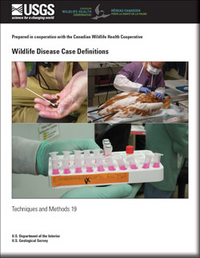Case Definitions for Wildlife Diseases
Links
-
Documents:
- Report (0.98 MB pdf)
- Editable template (121 kB) - —[Disease/Condition] Case Definition [Template] for Wildlife
- Chapters:
- Download citation as: RIS | Dublin Core
Abstract
Welcome to the first manual of “Case Definitions for Wildlife Diseases,” a “living” electronic publication. The plan is to add and update this manual’s case definitions periodically as warranted; thus, this manual will never be completed, and readers should download the latest versions of specific chapters (that is, definitions) when available. Constructive suggestions from readers are welcome and will help guide adjustments as this project progresses.
The purpose of this manual is to provide case definitions for selected diseases of importance to wildlife in Canada and the United States. Case definitions provide standard sets of criteria for classifying the degree of certainty of a particular diagnosis and help improve surveillance data quality and comparability. Better data and standardization allow for improved data sharing, which increases geographic and species surveillance coverage and permits more robust analyses.
The definitions included in this manual have been developed by veterinary pathologists, epidemiologists, and wildlife biologists primarily from the U.S. Geological Survey National Wildlife Health Center (NWHC) and Canadian Wildlife Health Cooperative (CWHC). Pathologists from each organization reviewed and finalized the definitions. Each case definition has been peer reviewed by two scientific experts before publication.
This manual begins with the case definition template. This generic template includes four sections: “Individual, Place, and Time Criteria for Diagnosis and Testing,” “Field Criteria for Diagnosis,” “Laboratory Criteria for Diagnosis,” and “Epidemiological Linkage Criteria for Diagnosis” and can be used to guide development of new case definitions. Information in each section is then combined to provide an overall case classification. Disease diagnoses are classified as “Confirmed,” “Presumptive,” or “Suspected;” and evidence of a pathogen or toxin is classified as “Exposed” or “Present/Detected.” Each subsequent chapter is then a case definition for a specific disease of wildlife, and infectious and non-infectious diseases are included.
| Publication type | Report |
|---|---|
| Publication Subtype | USGS Numbered Series |
| Title | Case definitions for wildlife diseases |
| Series title | Techniques and Methods |
| Series number | 19 |
| DOI | 10.3133/tm19 |
| Publication Date | March 15, 2024 |
| Year Published | 2024 |
| Language | English |
| Publisher | U.S. Geological Survey |
| Publisher location | Reston, VA |
| Contributing office(s) | National Wildlife Health Center |
| Description | 2 p. |
| Online Only (Y/N) | Y |
| Additional Online Files (Y/N) | N |


